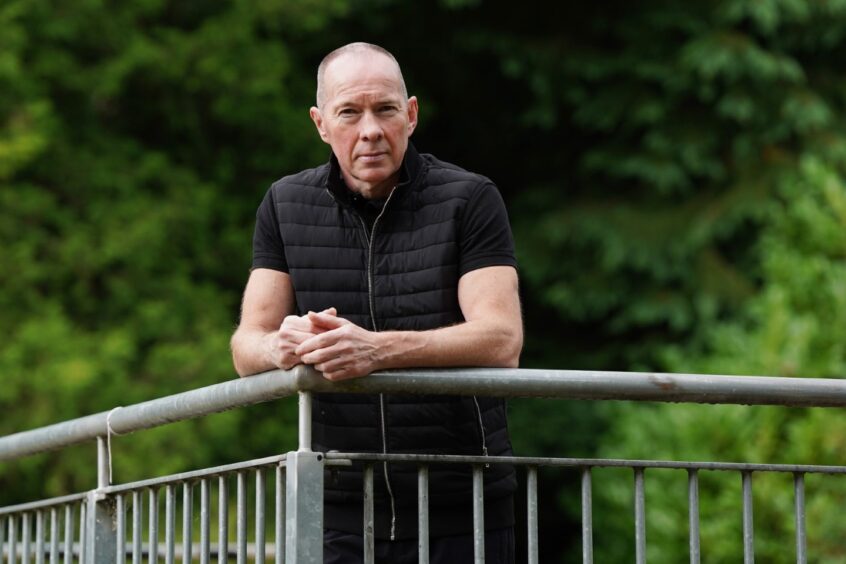
A former footballer has been left feeling suicidal after being warned he will have to wait more than a year for a prostate procedure that takes just THREE minutes.
Former Stenhousemuir player Mark Rodgers, 56, from Bathgate, has already suffered years of agonising pain because of an enlarged prostate. But as his condition worsened, and urologists assuring him he is “top of the list” as he cannot tolerate a urinary catheter because of potentially fatal side effects, NHS Lothian warn he will continue to wait “more than a year” for the Rezum procedure which would allow him to live a normal life.
As well as living in pain and with the ever-present life-threatening side effects of acute urine retention, Mark, also faces running out of sick pay and worries about losing his home.
The former football player and amateur boxer said: “The condition escalated until the pain brought me to my knees and there was blood in my urine.
“I’m one of the 1 in 10 men who cannot tolerate a catheter because it causes acute urine retention. This means I’m in constant threat of the life-threatening side effects and potential organ damage that this can cause. I have had to endure repeated hospital visits for emergency care as a result. On one occasion my bladder retained 1600mls of urine rather than the 400mls found in a full bladder.
“Despite being assured I’m top of the list for the Rezum procedure, I’ve now been told I’m another year away from getting this life-changing operation. It could be more.
“Right now, I’m having to self-catheterise and the danger of urine retention is a constant threat. I can’t work. I can’t be far from home because I need to self-catheterise. I used to exercise every day. That’s no longer an option. I was super-fit. I’d climb hills without thinking. I did 30,000 press-ups in 30 days to raise £2,000 for a cancer charity. Nobody appears even interested in my deteriorating mental health. I haven’t acted on my suicidal thoughts, but I’m terrified where depression is leading me.”
‘No end in sight’
Mark, a maintenance engineer for ScotRail, is worried about his family home when he can no longer pay the mortgage.
He said: “My sick pay is running out. What will happen then? I’d initially been told I might have to wait six weeks or so.
“Now NHS Lothian make it clear there’s no end in sight and the waiting period will be at least another year, maybe even more.”
In a stark letter to Mark, NHS Lothian sets out that it doesn’t have any money to pay overtime to allow medical staff to catch-up on the backlog which is the worst it has ever been – with 864,000 now on Scotland’s waiting list. In desperation Mark even complained to the health board as waiting times breach the Scottish Government’s 12-week Treatment Time Guarantee.
It upheld that part of his complaint and its letter states: “At the moment there is a wait of around a year for urgent procedures of this kind, and you are likely to wait at least this long. The urology service apologises for the current waiting times that are currently being experienced.” It adds: “The Treatment Time Guarantee is unlikely to be met for you on this occasion.”
As well as suffering urinary infections because of self-catheterisation, Mark has had to receive emergency hospital care on three occasions in the last three months because of that and dangerous levels of urine retention.
On one occasion in July the pain was so bad, Mark actually crawled into St John’s Hospital in Livingston for help.
He said: “Astonishingly none of them could deal with the catheter and it took them three hours to decide to send me to the Western General Hospital in Edinburgh instead. There were no ambulances, so my wife had to drive me as I writhed in pain. Nurses at the Western General were great. They dealt with the problem. But it was not without irony that the journey time between the two hospitals would have allowed the procedure I needed to be performed many times over.
“I also wonder how much my three trips to hospital to deal with the side effects of the catheter use have cost the NHS compared with the cost of just doing the Rezum procedure immediately.”
The Rezum procedure costs the NHS around £1,300 while private hospitals charge around £4,500. Last week it emerged there are currently 864,366 people on NHS waiting lists in Scotland.
Meanwhile Prostate Research UK called for a UK-wide testing service for prostate cancer, to solve the current “postcode lottery” of testing.
Michelle Carr, Chief Officer of Acute Services, NHS Lothian, said: “I apologise to patients who are waiting too long for treatment and I would reassure them that our teams are working hard to clinically prioritise those who are in most urgent need. All health boards, including NHS Lothian, are under significantly increased financial pressure. We are focusing our available funding on supporting internal, core capacity, and currently have no plans to use independent providers.”
The Scottish Government said: “We acknowledge that some people are waiting too long and we remain determined to provide the necessary support to drive improvements in waiting times. We will continue to target resources to this effect, particularly for people waiting the longest. Significant activity is already under way following the £30m investment to target backlogs, announced in the spring. This will see around 12,000 new outpatient appointments, around 12,000 inpatient procedures and over 40,000 diagnostic procedures delivered.”
Mark’s MSP Foysol Choudhury said: “Mark’s case is yet another example of the human cost of the SNP Government’s failure to support our NHS.
“The number of Scots languishing on NHS waiting lists for tests, appointments and treatment has soared to a record high and it is the people of Scotland like Mark who are paying the price.
“Mark’s case is unacceptable. He has been added to the waiting list with urgent priority, yet has been told it could be a year before he gets his treatment-way over the Treatment Time Guarantee of 12 weeks.
“That’s a year in pain, with reduced quality of life, having to take time off work and suffer the financial consequences, for a procedure which should only take a matter of minutes.
“I’ve been pursuing this case for Mark and will continue to do so for him, and others affected. We must save our NHS from SNP incompetence and ensure patients get the treatment they deserve. ”
The procedure: Patients can go home afterwards
The Rezum procedure for treating enlarged prostate can be done in as little as THREE minutes. A machine uses steam from a tiny needle passed through the urethra to remove the enlarged part of the prostate.
Patients are given either a local or general anaesthetic and go home afterwards.
Unlike other procedures which have longer recovery, Rezum allows patients to return to their normal activities within a few days and uniquely it lowers the risk of sexual function side effects and risk of bleeding. Improvements can be seen within three weeks.
NHS watchdogs agreed the revolutionary procedure from 2018.
Benign prostatic hyperplasia (BPH) is a non-cancerous enlargement of the prostate gland. Associated lower urinary tract symptoms (LUTS) become more common as men get older with risks increasing to 50% among men between 50 and 60 years old, to 70% for men over 70. An enlarged prostate puts pressure on the bladder and urethra affecting the ability to urinate.
Last week, NHS Scotland announced the worst ever waiting times with 864,000 cases, including 130,000 who have had their 12-week Treatment Time Guarantee broken, 149,912 waiting for eight key diagnostic tests, 556,896 waiting for outpatients and 155, 558 waiting on an in-patient appointment.
When life is difficult, Samaritans are here – day or night, 365 days a year. You can call them for free on 116 123, email them at jo@samaritans.org, or visit samaritans.org to find your nearest branch.

Enjoy the convenience of having The Sunday Post delivered as a digital ePaper straight to your smartphone, tablet or computer.
Subscribe for only £5.49 a month and enjoy all the benefits of the printed paper as a digital replica.
Subscribe © SYSTEM
© SYSTEM © Stewart Attwood
© Stewart Attwood